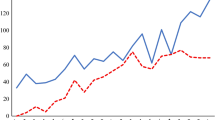Abstract
This paper is concerned with differences in the performance-flow relationship (PFR) between standard and specialist market segments of the mutual fund industry. We expect differences in this relationship because investor characteristics might vary across different segments. Our results show that the PFR is more convex in standard segments than in specialist segments. Furthermore, investors in standard segments are less risk-averse and invest more in high-load funds than investors in specialist segments. Our findings are consistent with investors in standard segments being less sophisticated than investors in specialist segments and relying more heavily on the advice of financial brokers, which is compensated for by load fees.
Similar content being viewed by others
References
BARBER, B. M., T. ODEAN and L. ZHENG (2004): “Out of Sight, Out of Mind: The Effects of Expenses on Mutual Fund Flows”, Journal of Business, forthcoming.
BERGSTRESSER, D. and J. POTERBA (2002): “Do After-Tax Returns Affect Mutual Fund Inflows?”, Journal of Financial Economics 63, pp. 381–414.
BOLLEN, N.P.B. and J.A. BUSSE (2001): “On the Timing Ability of Mutual Fund Managers”, Journal of Finance 56, pp. 1075–1094.
BROWN, S.J. and W.N. GOETZMANN (1995): “Performance Persistence”, Journal of Finance 50, pp. 679–698.
BROWN, K.C., W. HARLOW and L.T. STARKS (1996): “Of Tournaments and Temptations: An Analysis of Managerial Incentives in the Mutual Fund Industry”, Journal of Finance 51, pp. 85–110.
CARHART, M. (1997): “On Persistence in Mutual Fund Performance”, Journal of Finance 52, pp. 57–82.
CHEVALIER, J. and G. ELLISON (1997): “Risk Taking by Mutual Funds as Response to Incentives”, Journal of Political Economy 105, pp. 1167–1200.
DELGUERCIO, D. and P. TKAC (2002): “The Determinants of the Flows of Funds of Managed Portfolios: Mutual Funds vs. Pension Funds”, Journal of Financial and Quantitative Analysis 37, pp. 523–558.
ELTON, E.J., M.J. GRUBER and C.R. BLAKE (1996): “The Persistence of Risk-Adjusted Mutual Fund Performance”, Journal of Business 69, pp. 133–157.
ELTON, E.J., M.J. GRUBER and C.R. BLAKE (2000): “Incentive Fees and Mutual Funds”, Journal of Finance 58, pp. 779–804.
FAMA, E.F. and K.R. FRENCH (1993): “Common Risk Factors in the Return on Bonds and Stocks”, Journal of Financial Economics 33, pp. 3–53.
FAMA, E.F. and J. MACBETH (1973): “Risk, Return, and Equilibrium: Empirical Tests”, Journal of Political Economy 81, pp. 607–36.
FANT, L.F. and E.S. O’NEAL (2000): “Temporal Changes in the Determinants of Mutual Fund Flows”, Journal of Financial Research 23, pp. 353–371.
GLASER, M., T. LANGER and M. WEBER (2003): “On the Trend Recognition and Forecasting Ability of Professional Traders”, CEPR Working Paper No. 3904.
GOETZMANN, W. and N. PELES (1997): “Cognitive Dissonance and Mutual Fund Investors”, Journal of Financial Research 20, pp. 145–158.
HUANG, J., K.D. WEI and H. YAN (2005): “Participation Costs and the Sensitivity of Fund Flows to Past Performance”, Working Paper.
IPPOLITO, R.A. (1992): “Consumer Reaction to Measures of Poor Quality: Evidence from the Mutual Fund Industry”, Journal of Law and Economics 35, pp. 45–70.
JAIN, C.J. and J.S. Wu (2000): “Truth in Mutual Fund Advertising: Evidence on Future Performance and Fund Flows”, Journal of Finance 55, pp. 937–958.
Kaplan, S. and schoar, a. (2005): “Private Equity Performance: Returns, Persistence and Capital Flows”, Journal of Finance, forthcoming.
KEMPF, A. and S. RUENZI (2004a): “Family Matters: The Performance Flow Relationship in the Mutual Fund Industry”, Working Paper.
KEMPF, A. and S. RUENZI (2004b): “Die Qual der Wahl: Eine empirische Untersuchung zum Status-Quo Bias im Fondsmarkt”, in: M. Bank and B. Schiller (eds), Finanzintermediation—Theoretische, wirtschaftspolitische und praktische Aspekte aktueller Entwicklungen im Bank- und Börsenwesen, Stuttgart: Schäffer-Poeschel, pp. 103–122.
KEMPF, A. and S. RUENZI (2005): “Tournaments in Mutual Fund Families”, Working Paper.
KHORANA, A. (1996): “Top Management Turnover: An Empirical Investigation of Mutual Fund Managers”, Journal of Financial Economics 40, pp. 403–427.
PATEL, J., R.J. ZECKHAUSER and D. HENDRICKS (1994): “Investment Flows and Performance: Evidence from Mutual Funds, Cross-Border Investments, and New Issues”, in: R. Sato, R.M. Levich and R.V. Ramachandran (eds), Japan, Europe and International Financial Markets: Analytical and Empirical Perspectives, Cambridge: Cambridge University Press, pp. 51–72.
SAWICKI, J. (2000): “Investors’ Response to the Performance of Professional Fund Managers: Evidence from the Australian Funds Wholesale Market”, Australian Journal of Management 25, pp. 47–67.
SAWICKI, J. (2001): “Investors’ Differential Response to Managed Fund Performance”, Journal of Financial Research 24, pp. 367–384.
SHEFRIN, H. and M. STATMAN (1985): “The Disposition to Sell Winners Too Early and Ride Losers Too Long: Theory and Evidence”, Journal of Finance 40, pp. 777–790.
SHILLER, R.J. (1984): “Stock Prices and Social Dynamics”, Brookings Papers on Economic Activity 2, pp. 457–510.
SIRRI, E. and P. TUFANO (1998): “Costly Search and Mutual Fund Flows”, Journal of Finance, pp. 1589–1622.
Author information
Authors and Affiliations
Corresponding author
Rights and permissions
About this article
Cite this article
Ruenzi, S. Mutual Fund Growth in Standard and Specialist Market Segments. Fin Mkts Portfolio Mgmt 19, 153–167 (2005). https://doi.org/10.1007/s11408-005-3383-3
Published:
Issue Date:
DOI: https://doi.org/10.1007/s11408-005-3383-3



